
Search Wild Foods Home Garden & Nature's Restaurant Websites:
Staghorn and Smooth Sumac
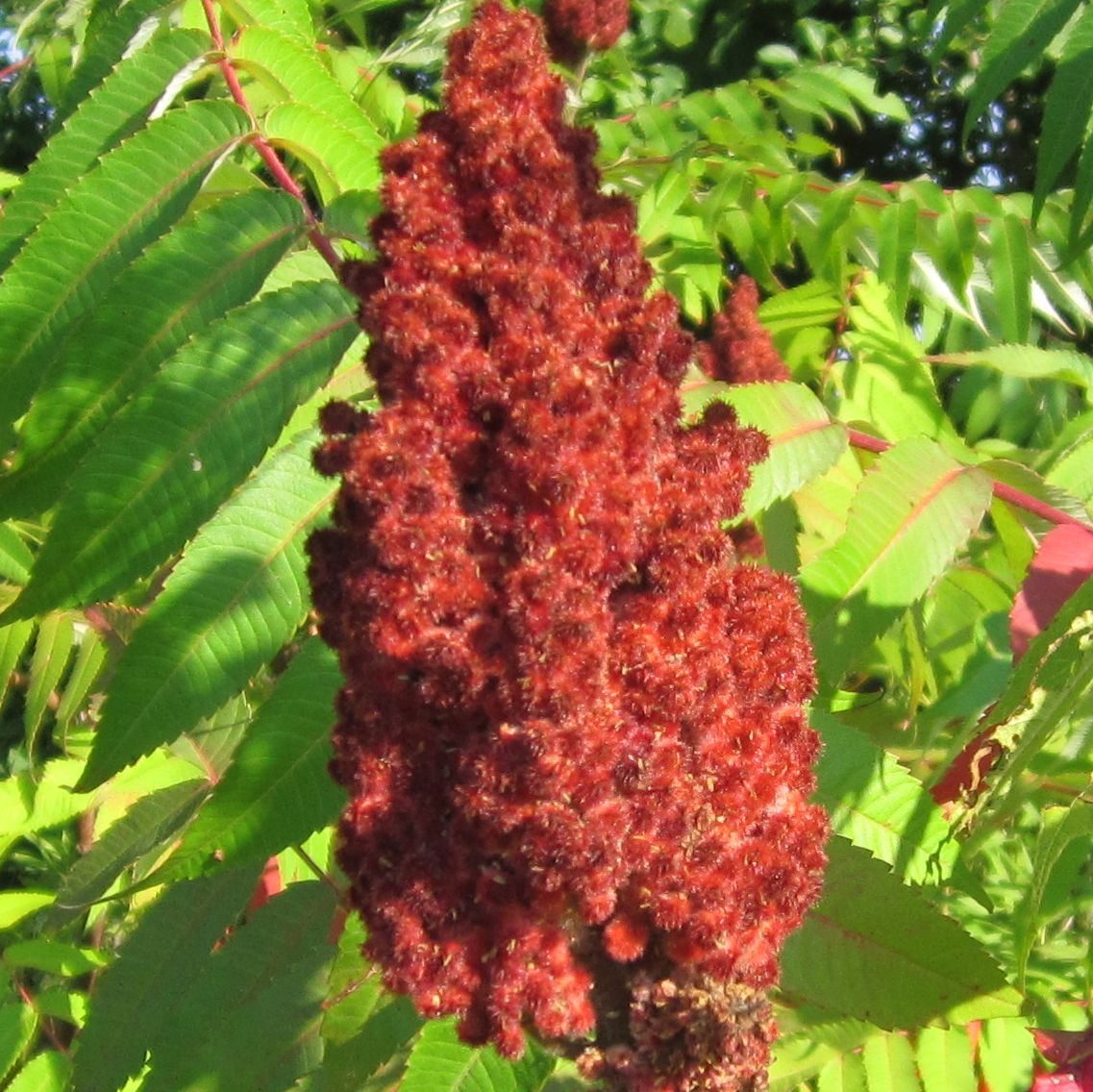
Close up of perfect Staghorn Sumac berries (called drupes) on this cluster (called a panicle) ripe for picking (which I did with this one).
(NOTE: If you are not interested in growing Staghorn and Smooth Sumac, but just finding the berries, try going to the Nature's Restaurant Online site Staghorn and Smooth Sumac page.)
Staghorn Sumac (Rhus typhina) and the Smooth Sumac (Rhus glabra). The berry clusters are beautiful to look at, and actually make a nice drink. Like anything you have never had before, make sure you have very little at first to make sure you aren't allergic. It doesn't matter which one - the Staghorn or Smooth Sumac, as they are the same from an eating perspective.
This is a well regarded ornamental, and there are different cultivars of it available at nurseries. You can also start it by seed or transplanting a small one.
Seeds: You can start a Sumac from seed, but it is not just planting it in the ground. You have to either cut the hard shell without damaging the seed inside, or bring a pot of water to a boil, turn off, toss the seeds in, and leave until the water cools. Next, take the seeds and mix with some damp but not wet peat moss and put in a sealed freezer bag in the fridge - not freezer. Leave for a month or so. After, plant the seeds 3mm (1/8 inch) deep in a pot with potting soil, mist it until it is moist, cover with a clear plastic bag and put a rubber band around the bag and pot to seal in the moisture. Put the pot in a warm area away from direct sun. Once they have sprouted, take off the bag and mist to keep moist and grow in a bright, but not direct burning sun spot. Transplant in the spring into the ground and keep moist for the first season. Part sun, part shade would be best, but if no shade where they are transplanted to, cover them from direct mid-day sun after transplanting. A plastic chair over them would do well and let in the morning and evening sun.
Transplanting: Transplanting is straight forward. Try to get as big diameter around the Sumac as possible. Don't transplant very little ones, or really large ones. Between 60-100 cm (2-3 feet) high is about right. The roots are shallow, so 20 cm (10 inches) deep is good enough. Most likely the one you transplant will be a root sucker from a larger one nearby, so cut that root as far from the one you are transplanting as you can. Put in a hole and cover with the soil from the hole mixed with composted manure or compost. Cover around the new tree with about 5-7.5 cm (2-3 inches) of mulch. Water well and keep wet for the first year if done in spring. If done in the fall, water well after planting, and the next year don't let it dry out.
Soil & Site: If you have alkaline soil, your better bet is the Smooth Sumac. Both can do well in soils that are a little acidic to neutral. They like full sun, but can do fine if they spend some of the day in shade. The best soil is rich in organic matter, well drained and moist. After planting, cover the ground with mulch to help keep the soil moist. The Smooth Sumac is also the better choice for drier conditions.
Maintenance: This plant will spread readily by the roots and can take over an area by forming clonal colonies. If you plant in an area where it is mowed around, this will keep it in check. Add some mulch around them each fall - leaves from the rest of the surrounding yard is a great way to get rid of them and mulch these. There isn't much else to do for them.
Harvesting: In the late summer to early fall the clusters of berries will be bright red and ready to pick. Cut below the cluster with a sharp knife, pruners or sharp, strong scissors and take inside to use.
Using: When the Staghorn and Smooth Sumac berry clusters are ripe, pick two or three clusters off the plant, take home and remove the outer, healthy looking berries into a bowl, pour warm, but not boiling water over them. Rub the berries around with your hands, then let soak for about half an hour. Take the mix and pour into a clean coffee filter over a pot, or through a clean and well rinsed tea towel. Put the pinkish red drink in a fridge to cool, or over ice to have right away. Keeps for a day or two without a problem. This drink cuts thirst better than almost anything else.
If you find the mix you made too sharp, just dilute with cold water.
Web Resources:
Recipe search on the web here (Google search) and here (Bing search).
Make sure you know what a Poison Sumac (Toxicodendron vernix) looks like. The leaves are similar looking to the Staghorn Sumac, and especially the Smooth Sumac at first glance - they are compound leaves. To be safe, DO NOT touch a Sumac unless you see the red berry clusters like in the included picture below. The Poison Sumac has white, green or grey colored berries. The Poison Sumac likes very damp or wet land. The Staghorn and Smooth Sumac likes well drained hilly areas, though they are often by water - just not in standing water or soaked land. Don't bother with anything that looks like a Sumac if it is damp or wet in the area until you see the red berry clusters.
Staghorn Sumac
Staghorn Sumac (Rhus typhina):
- USDA Plant Hardiness Zone: 5-8 (More information on hardiness zones).
- Soil pH: 5.5-7.0
- Plant Size: 5 meters (16 feet) tall
- Duration: Perennial Shrub
- Leaf Shape: Odd Pinnate compound leaves with 9-31 leaflets
- Leaf Phyllotaxis (Arrangement) on branch: Alternate
- Leaf Size: Each leaflet is 6-11 cm (2 1/3 to 4 1/3 inches) long
- Leaf Margin: Serrated (saw toothed edge)
- Leaf Notes: In the fall, the leaves turn a beautiful red, orange and sometimes yellow
- Flowers: Soft white to yellowish-green in dense clusters on the ends of branches
- Fruit: Dense clusters of small, fuzzy red berries (drupes) on the ends of the branches
- Bark: Light grey and brown with orange-tan horizontal lenticels (checking)
- Habitat: Dry soils, edges of woods, abandoned land, waste areas, very often on the sides of hills forming clonal colonies from spreading by the roots. Can tolerate very poor, dry soils. Often found on sandy soils by rivers, but rarely where the soil is always wet.
Web Resources:
- Pictures on the web here (Google images) and here (Bing images).
- Interactive USDA distribution map and plant profile here.
- The Biota of North America Program (BONAP) distribution map here. BONAP map color key here.

Staghorn Sumac (Rhus typhina) range. Distribution map courtesy of the USGS Geosciences and Environmental Change Science Center, originally from "Atlas of United States Trees" by Elbert L. Little, Jr. .
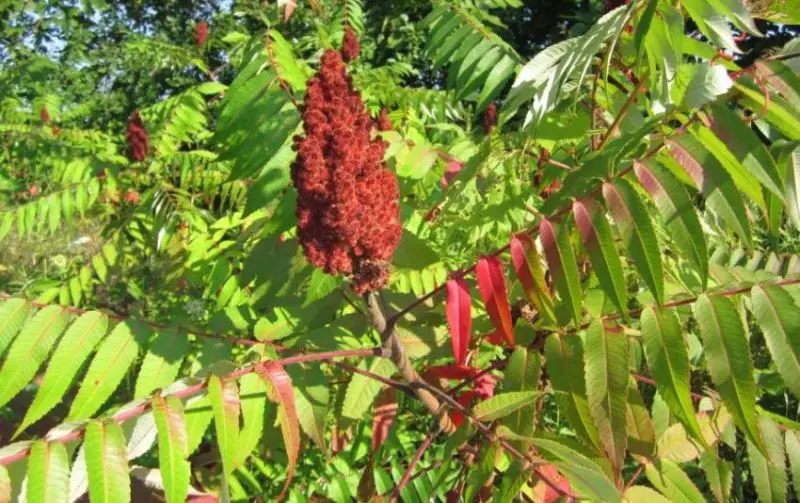
Staghorn Sumac (Rhus typhina) with drupe panicles (berry clusters) ready for harvest. These were found mid August, and are usually good right into late September.
Staghorn Sumac (Rhus typhina) growth early in the season. (By: Eike Wulfmeyer Attribution-Share Alike 2.5 Generic)
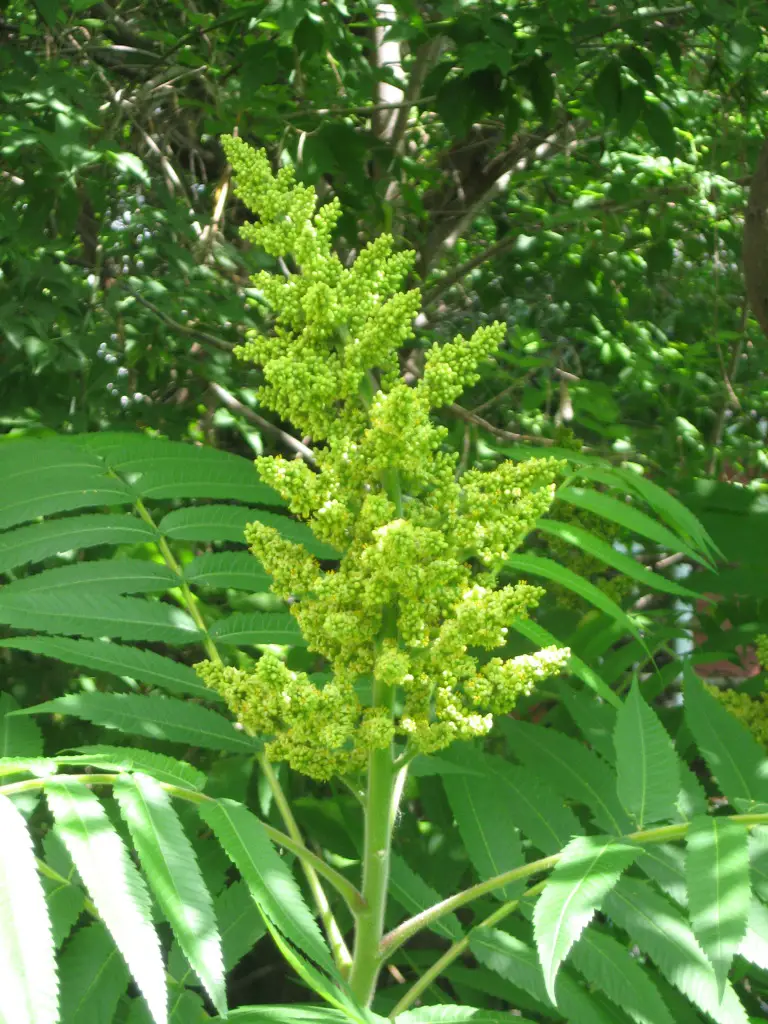
Staghorn Sumac (Rhus typhina) male flower panicle at the early stage. Male flower panicles come out in June/July. These will not turn into the edible berry clusters - those are female. (By: Lubiesque CC BY-SA 3.0)
Staghorn Sumac (Rhus typhina) branch after leaves have fallen off. You can see where the leaf was attached. This picture clearly shows why it is called the Staghorn - the fuzzy branch looks like a deer stag's antler - see the picture below this one. (By: Aha GNU Free Documentation License, Version 1.2)

Red deer stag velvet on antler. (By: Mehmet Karatay CC BY-SA 3.0)
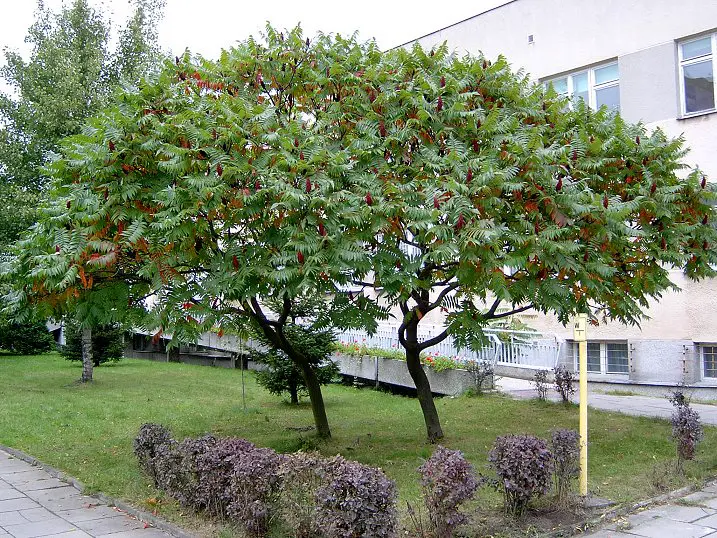
These trees are very beautiful edible landscaping trees. (By: Brosen CC BY-SA 3.0)
Smooth Sumac
Smooth Sumac (Rhus glabra):
Description:
- USDA Plant Hardiness Zone: 5-11 (More information on hardiness zones).
- Soil pH: 5.0-8.0
- Plant Size: Can reach 5 meters (16 feet) but usually no more than 3 meters (10 feet) tall
- Duration: Perennial Shrub
- Leaf Shape: Odd Pinnate compound with 9-31 leaflets
- Leaf Phyllotaxis (Arrangement) on branch: Alternate
- Leaf Size: The compound leaf is up to 50 cm (20 inches) long, each leaflet is 5-11 cm (2 to 4 1/3 inches) long. Lower side of leaf is whitish, while upper side is green.
- Leaf Margin: Serrated (saw toothed edge)
- Leaf Notes: The stems of the compound leaves are a purplish red color. Leaves turn a very beautiful scarlet red in the fall
- Flowers: Small green dense clusters (panicle) on the ends of branches and are upright - not drooping. Up to 25 cm (10 inches) long
- Fruit: Red, orange-red fruit that is almost smooth - not very fuzzy like the Staghorn Sumac
- Bark: Smooth, grey to brown.
- Habitat: Dry to moist areas, tolerates a very wide variety of soils including fairly high alkalinity compared to other Sumacs. Will form clonal colonies.
Web Resources:
- Pictures on the web here (Google images) and here (Bing images).
- Interactive USDA distribution map and plant profile here.
- The Biota of North America Program (BONAP) distribution map here. BONAP map color key here.

Smooth Sumac (Rhus glabra) range. Distribution map courtesy of the USGS Geosciences and Environmental Change Science Center, originally from "Atlas of United States Trees" by Elbert L. Little, Jr. .
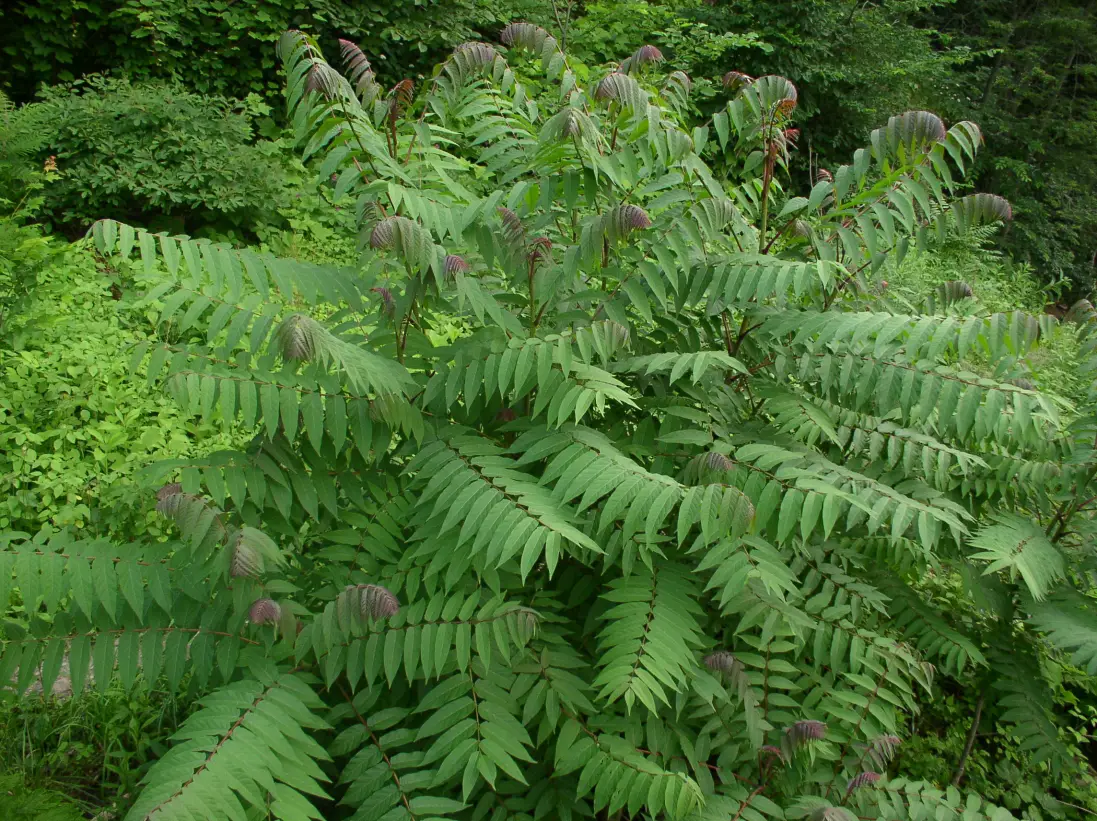
Smooth Sumac (Rhus glabra) early in the season. The new growth has the purplish color. (By: Richtid CC BY-SA 3.0)
.jpg)
Smooth Sumac (Rhus glabra) male flower panicle. Male flower panicles come out in June/July. (By: Superior National Forest Attribution 2.0 Generic)
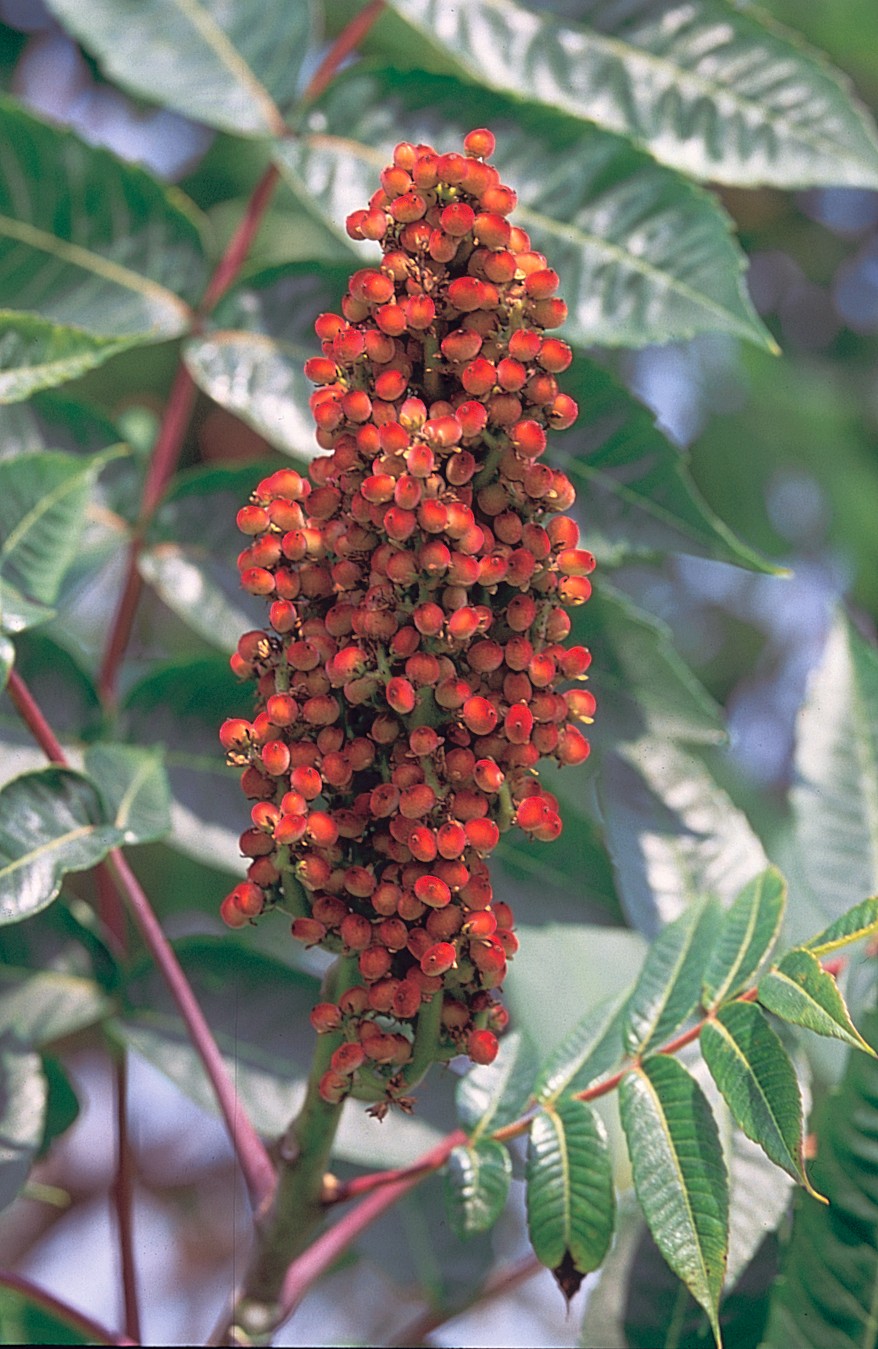
Smooth Sumac (Rhus glabra) drupe panicle (berry cluster). (By: USDA)
Search Wild Foods Home Garden & Nature's Restaurant Websites:
Share:
Why does this site have ads?
Originally the content in this site was a book that was sold through Amazon worldwide. However, I wanted the information to available to everyone free of charge, so I made this website. The ads on the site help cover the cost of maintaining the site and keeping it available.
Google + profile
